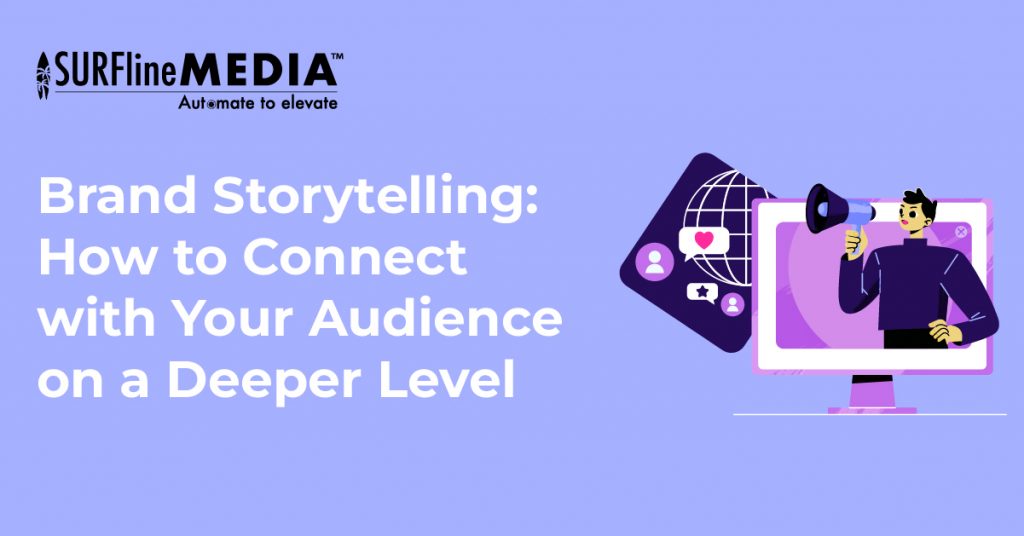

- Janelle Tran
- July 7, 2023
- 4:00 pm
- No Comments
Brand Storytelling: How to Connect with Your Audience on a Deeper Level
Effective storytelling has emerged as a vital tool for brands seeking to make a lasting impact. With consumers inundated by countless marketing messages, brand storytelling offers a unique opportunity to captivate attention, foster emotional connections, and shape a distinctive brand identity. In this article, we will explore the art of brand storytelling, and practical ways for crafting compelling narratives that resonate with your target audience.
What is Brand Storytelling?
Brand storytelling is about creating a cohesive and authentic narrative that brings the brand to life, communicates its purpose, and establishes a strong emotional connection with customers. It allows businesses to convey their unique identity, values, and mission in a way that captivates and inspires their target audience.
Brand storytelling and content creation are closely intertwined. Content creation provides the medium through which brand stories are delivered. It allows brands to craft and share their narratives effectively, using different types of content to engage, inform, and entertain their audience. By leveraging storytelling techniques within their content, brands can capture attention, evoke emotions, and create memorable experiences for their audience.
The Powerful Role of Storytelling in Branding
Creating Emotional Connections
When a brand can evoke emotions and establish a deep connection with its audience, it becomes more than just a product or service—it becomes a part of their lives. Emotional connections build trust, loyalty, and affinity towards a brand, leading to increased customer engagement and long-term relationships.
Numerous studies and research have emphasized the importance of emotional connections in branding. According to a study by Forrester, emotionally engaged customers are more likely to become loyal, repurchase, and recommend a brand to others. The research found that emotionally connected customers have a 306% higher lifetime value than customers who are merely satisfied with a brand’s functional benefits.
Brand storytelling involves crafting narratives that resonate with the target audience, tapping into their values, aspirations, and desires. Through storytelling, brands can communicate their purpose, vision, and values, creating a sense of shared identity with their customers. Brands may generate feelings such as joy, nostalgia, empathy, and inspiration by using sympathetic characters, captivating storytelling, and evocative images.
Shaping Brand Identity
Brand identity refers to the unique set of values, attributes, and characteristics that define a brand and distinguish it from competitors. It encompasses elements such as brand name, logo, tagline, and brand messaging. Establishing a strong brand identity is essential for creating brand recognition, building customer trust, and fostering brand loyalty.
Brand storytelling is a powerful tool used to shape brand identity. It involves using narratives and storytelling techniques to communicate a brand’s values, purpose, and personality to consumers. By crafting compelling and authentic stories, brands can connect with their target audience on an emotional level and establish a deeper and more meaningful relationship. Through storytelling, brands can effectively communicate their unique selling proposition, showcase their brand values, and illustrate how their products or services can fulfill customers’ needs and desires.
Furthermore, brand storytelling can continue to enhance brand authenticity, a critical factor in today’s consumer landscape. Consumers seek authenticity in the brands they support, and storytelling provides a means to showcase a brand’s genuine values, beliefs, and mission. 86% of consumers believe authenticity is a key factor when deciding which brands they like and support
Captivating Attention
Brand storytelling has the ability to captivate attention by creating narratives that are compelling, immersive, and emotionally resonant. When brands craft stories that tap into consumers’ emotions, values, and aspirations, they can capture attention and hold it for longer periods. A study by Nielsen Consumer Neuroscience revealed that emotionally engaging ads are more likely to capture attention and be remembered by viewers.
Percentages provide evidence of the impact of captivating attention through brand storytelling. A study by HubSpot found that 55% of website visitors spend less than 15 seconds on a webpage. This highlights the challenge brands face in capturing attention and engaging visitors. However, research has shown that effective storytelling can help to address this issue.
Moreover, captivating attention through brand storytelling also extends to social media platforms. Social media posts with storytelling elements generate higher engagement rates compared to posts that solely focus on promotional content. Brands that can effectively craft narratives that capture attention in social media feeds have a greater chance of reaching and connecting with their target audience.
Building Trust and Authenticity
How brand storytelling contributes to building trust is a result of creating emotional connections with consumers. By sharing authentic stories about the brand’s origins, values, and mission, companies can evoke emotions such as empathy, nostalgia, or inspiration. According to a study by Fast Company, 90% of consumers are more likely to be loyal to brands that emotionally connect with them. By tapping into emotions through storytelling, brands can foster a sense of trust and forge deeper connections with their target audience.
Besides, authenticity is also closely tied to trust-building. Consumers are increasingly seeking authentic experiences and genuine interactions with brands. Authenticity involves being true to one’s values, promises, and actions. When a brand’s storytelling aligns with its actual practices and beliefs, it establishes a sense of authenticity.
In the digital age, where information is easily accessible, consumers are becoming more skeptical of marketing tactics and traditional advertising. Brand storytelling provides an opportunity for brands to cut through the noise and engage with their audience in a more meaningful way.
How to Create a Brand Story
1. Define your brand’s purpose and values
Start by clearly defining your brand’s purpose and the values that drive it. Ask yourself why your brand exists and what it aims to achieve. Identify the core principles and beliefs that guide your brand’s actions and decisions.
2. Identify your target audience
Understand who your target audience is and what they care about. Conduct market research and create buyer personas to gain insights into their needs, desires, and motivations. By understanding your audience, you can tailor your brand story to resonate with them on a personal level, making it more compelling and relevant.
3. Craft a narrative that connects emotionally
Develop a narrative that captivates and engages your audience emotionally. Start with a compelling opening that grabs their attention and introduces the core message of your brand. Consider incorporating elements such as storytelling techniques, descriptive language, and emotions to create a connection. Your brand story should evoke emotions that align with your brand’s values and resonate with your audience’s aspirations and desires.
4. Align your brand story with visuals and consistency
Ensure that your brand story aligns with your visual identity and overall messaging. Use visuals, such as images and videos, to enhance your brand story and create a more immersive experience. Consistency is key; make sure that your brand story is reflected consistently across all touchpoints, including your website, social media, and marketing materials.
5. Share and reinforce your brand story
Once your brand story is crafted, it’s time to share it with the world. Incorporate your brand story into your website’s About Us page, social media posts, and marketing campaigns. Encourage employees, customers, and brand advocates to share your brand story as well, amplifying its reach. Reinforce your brand story through consistent messaging and storytelling in all your communications and interactions with your audience.
Brand Storytelling Examples
Nike is renowned for its exceptional brand storytelling, leveraging the power of emotions to inspire and motivate its audience. The brand’s “Just Do It” campaign, launched in 1988, has become an iconic example of effective storytelling. Nike’s advertisements often feature real stories of athletes overcoming obstacles, pushing their limits, and achieving greatness. By showcasing these inspiring narratives, Nike taps into the universal human desire for personal growth and triumph. Their brand story revolves around the themes of determination, perseverance, and empowerment, resonating with individuals who strive to reach their full potential.

Image: Nike’s brand storytelling (source: SmartInsights)
Coca-Cola has mastered the art of brand storytelling, successfully captivating audiences for decades with its heartwarming and uplifting narratives. The brand’s storytelling revolves around the idea of happiness, togetherness, and creating moments of joy. Coca-Cola’s advertisements often depict scenarios where people from diverse backgrounds come together, share a Coke, and experience moments of connection and celebration. Through storytelling, Coca-Cola fosters a sense of nostalgia and a feeling of universal happiness. Their campaigns are known for evoking emotions and creating a sense of belonging, making consumers feel a part of a larger community.

Image: Coca-Cola’s brand storytelling (source: MarTech)
Conclusion
Brand storytelling has emerged as a powerful tool for businesses to connect with their audience and stand out in today’s competitive digital landscape. At Surfline Media, we understand the significance of brand storytelling in creating compelling narratives that resonate with consumers. By leveraging our expertise in content creation and engaging brand stories, Surfline Media helps businesses build trust, establish credibility, and foster lasting connections with their target audience. Explore our content creation service and contact us today.
_______________________

Surfline Media – Automate to Elevate
Our website: https://surflinemedia.com/
Contact us: https://surflinemedia.com/contact-us/
Phone number: +1 323-741-4482
Email: [email protected]






